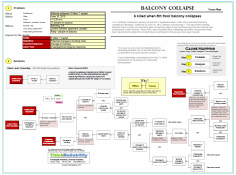An outbreak of Legionnaires’ disease has affected at least 115 and killed 12 in the South Bronx area of New York City. While Legionnaires’, a respiratory disease caused by breathing in vaporized Legionella bacteria, has struck the New York City area before, the magnitude of the current outbreak is catching the area by surprise. (Because the vaporization is required, drinking water is safe, as is home air conditioning.) It’s also galvanizing a call for actions to better regulate the causes of the outbreak.

Next we capture the impact to the goals. The safety goal is impacted due to the 12 deaths, and 115 who have been infected. The customer service goal is impacted by the outbreak of Legionnaires’. The environmental and property goals are impacted because at least eleven cooling towers in the area have been found to be contaminated with Legionella. The issue is resulting in increased regulation, an impact to the regulatory goal, and testing and disinfection, which is being performed by at least 350 workers and is an impact to the labor goal.
The analysis begins by asking “why” questions from one of the impacted goals. In this case, the deaths resulted from an outbreak of Legionnaires’ disease. The outbreak results from exposure to mist from one of the contaminated cooling towers. The design of some cooling towers allows exposure to the mist produced. It is common for water sources to contain Legionella (which again, is resistant to chlorine) but certain conditions allow the bacteria to “take root”: the damp warm environment found in cooling towers and insufficient cleaning/ disinfection. The cost of cleaning is believed to be an issue – studies have found that, like this outbreak, impoverished areas are more prone to these types of outbreaks. Additionally, there are insufficient regulations regarding cooling towers. The city does not regularly inspect cooling towers. According to the mayor and the city’s deputy commissioner for disease control, there just hasn’t been enough evidence to indicate that cooling towers are a potential source of Legionnaires’ outbreaks.
Evidence would indicate otherwise, however. A study that researched risk factors for Legionnaires’ in New York City from 2002-2011 specifically indicated that proximity to cooling towers was an environmental risk. A 2010 hearing on indoor air quality discussed Legionella after a failed resolution in 2000 to reduce outbreaks at area hospitals. New York City is no stranger to Legionnaires’; the first outbreak occurred in 1977, just after Legionnaires’ was identified. There have been two previous outbreaks of Legionnaires’ this year. Had there been a look at other outbreaks, such as the 2012 outbreak in Quebec City, cooling towers would have been identified as a definite risk factor.
For now, though the outbreak appears to be waning (no new cases have been reported since August 3), the city is playing catch-up. Though they are requiring all cooling towers to be disinfected by August 20 and plan increase inspections, right now there isn’t even a list of all the cooling towers in the city. Echoing the frustrations of many, Bill Pearson, member of the committee that wrote standards to address the risk of legionella in cooling towers, says “Hindsight is 20-20, but it’s not a new disease. And it’s not like we haven’t known about the risk of cooling towers, and it’s not like people in New York haven’t died of Legionnaires’ before.”
Ruben Diaz Jr., Bronx borough president, brings up a good point for the cities that may have Legionella risks from cooling towers, “Why, instead of doing a good job responding, don’t we do a good job proactively inspecting?” Let’s hope this outbreak will be a call for others to learn from these tragic deaths, and take a proactive approach to protecting their citizens from Legionnaire’s disease.









